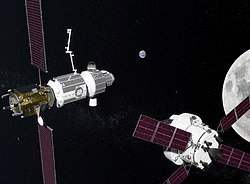 NASA plans to assemble a Lunar Gateway as a permanent base in lunar orbit during the 2020s. | |
This article documents expected notable spaceflight events during the 2020s.
 NASA plans to assemble a Lunar Gateway as a permanent base in lunar orbit during the 2020s. | |
This article documents expected notable spaceflight events during the 2020s.
The trend towards cost reduction in access to orbit is expected to continue. Vulcan is replacing its more expensive predecessors. Since 2023, SpaceX is testing its fully reusable Starship with orbital missions. In 2024, Blue Origin plans the maiden flight of New Glenn with a reusable first stage and Ariane 6 is expected to replace the retired more expensive Ariane 5.
Mars stays a focus for missions to other planets, with three missions launched in 2020 (by China, the United Arab Emirates and the United States) and at least one mission planned for 2024, 2026 and 2028.
In 2028, as part of the NASA-ESA Mars Sample Return mission, NASA plans to launch a Sample Retrieval Lander. In 2027, ESA plans to launch the Earth Return Orbiter, which will transport the retrieved samples from Mars to Earth by 2033. China is also planning to retrieve samples from Mars by 2031.
NASA plans a return of humans to the Moon by 2025. The first uncrewed launch of the Space Launch System happened in 2022. [1] The first crewed launch is planned for September 2025. [2] In addition NASA plans to assemble the Lunar Gateway in lunar orbit. A crewed exploration of Mars could follow in the mid 2030s. SpaceX, a private company, has also announced plans to land humans on Mars in the 2020s, with the long-term goal of enabling the colonization of Mars.
India plans to launch its first crewed flight with a spacecraft called Gaganyaan on a home-grown GSLV Mark III rocket in 2027. [3] The mission would make India the fourth nation to launch a crewed spaceflight after Russia, the US and China. India also plans to launch its second Mars probe, Mars Orbiter Mission 2 (Mangalyaan 2).
The James Webb Space Telescope was launched in 2021. NASA plans to launch the Nancy Grace Roman Space Telescope, which will have a field of view 100 times larger than that of the Hubble Space Telescope, between October 2026 and May 2027. [4] [5] [6]
NASA's NEO Surveyor, scheduled to launch no later than June 2028, [7] is expected to be capable of detecting at least 90% of near-Earth objects larger than 140 meters (460 ft), a goal mandated by the US Congress in 2005. [8]
The number of small satellites launched annually was expected to grow to around one thousand (2018 estimate), mainly communication satellites in large constellations [9] but launches quickly exceeded this estimate, mainly due to the rapid deployment of the Starlink and OneWeb constellations. From 2020 to 2022, around 3500 Starlink satellites [10] and 500 satellites by OneWeb [11] were launched.
The number of total satellites reached 10,000 for the first time in 2024. [12]